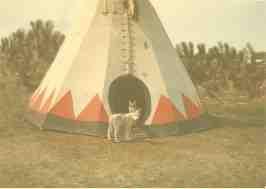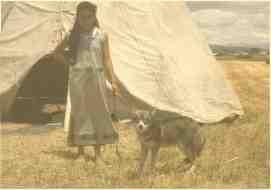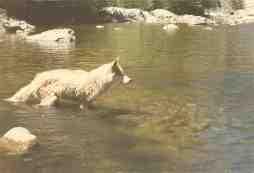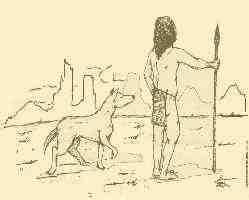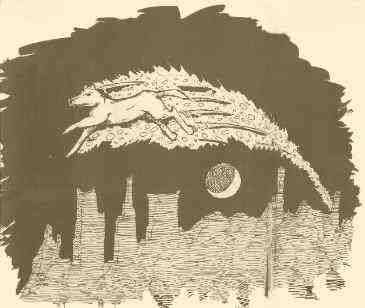|
Song
Dog Kennels
|
|
|
|
Home
of SONG DOG KENNELS -- Sole copyrighted Registry for the AMERICAN
INDIAN DOGS
|
|
(PLEASE
BE PATIENT WHILE THIS PAGE LOADS - THERE ARE MANY GRAPHICS AND
DOCUMENTS, IT WILL BE WORTH THE WAIT. THANK YOU )
MODERN FOUNDATION
HISTORY
FOUR FOOTED TRIBE MEMBERS
Native
American Folklore has many tales of dogs Dogs played an important part in the lives of most Native Americans. Tribes with flocks used dogs to tend them. Nomadic tribes employed dogs to help in the hunt and to guard the camp. The Makah of coastal Washington developed a breed specifically for its coat; they sheared the dogs like sheep and wove clothing from the soft fur. It was only natural that stories should be told about these important four-footed members of the tribes. Many of the stories dealt with dog's role in the world's creation or as a helper of - and sometimes troublemaker for - people One of the most startling tales tells us that the dog existed prior to the creation of the world. The Kato Indians of California tell of the Great Traveler, who was going around the world creating things and took along a dog for company. He didn’t create the dog: It was simply unthinkable that there shouldn’t be one. Presumably this ever-present dog resembled those kept by the Kato themselves; small, looking much like a coyote, with a pointed face and short hair. The Jicarilla Apache, on the other hand, tell a story of dog's creation. Black Hactcin, their creator, took some yellow from the sunset and made a yellow patch above one eye of the dog. Then he takes some white from the morning sky and put a white stocking on each paw. These marks signified that the dog would protect people forever, both morning and night. Black Hactcin then made man as a companion for the dog. When man laughed, the dog was very happy and ran around in circles and jumped up on the man, just as dogs do today. The Joshua Athapascans believe that dogs were the first beings made by their creator-figure, Xowala'ci. The creator rubbed grass and mud together to make two figures, and put them in a house. Four days later, a dog and a bitch came out. Twelve days after that, the bitch had pups. Xowala'ci was very pleased and made food for them. All dogs are descended from that first litter, and to this day they look up at the sky and howl, crying for their first father, Xowala'ci, whom they have never seen. The Yurok believe that people descended from dogs. Ki-melolemoniol, one of a group of spirits known as "Those through whom we live," resided with a bitch. She bore him first a girl, then a boy. When he expressed a desire for two dogs, she bore him two puppies. When there were more people, the dogs were put out of the house and fell into following men, but men first came from dogs. Gluskap is the culture hero/transformer of the Micmac of New Brunswick. The legends don't explain how Gluskap came to have dogs but they do relate that when it came time for Gluskap to leave this world, he left his dogs behind to care for people. He told the dogs that whenever they found a beaver, moose or deer, they should call to their masters. That is why dogs bark today. The Nutkenos say that in the dark forests of the Northwest, there were deer with no antlers, dogs with no tails, geese with no wings and a lone woman. The woman lamented her condition day and night until the god Quatz took pity and appeared to her. Upon seeing him, she cried even harder and her tears fell to the sand. Quatz commanded her to look, and she saw that a tiny infant was there completely formed. At the same moment, the deer sprouted antlers, the dog grew a tail and the geese rose into the air on wings. From that day forward, all animals could give birth to their own kind. These
legends address far more than the creation of dogs and people.
Many of them describe the heavens, explaining the formations
that are found there.
Indians found a variety of shapes in the full moon; from
the Shawnee's creatress Our Grandmother and her little dog to
an Eskimo sledge drawn by a single dog.
But the tales go well beyond the moon.
|
The Milky Way is explained by the Cherokee. They say that a southern people pounded white corn every night. One morning, they found that some meal was missing. They watched the next night and saw a little dog approach from the north and begin to eat the meal. The people chased the dog and he ran back into the north and up into the sky, leaving a white trail called 'where the dog ran:
The Iroquois tell of three brothers and the dog owned by the middle brother. They were having no luck in the hunt because a huge bear was devouring all the game. So they began following the bear. Finally, they came to the edge of the world and saw the bear running up the northern sky. The brothers climbed up after him. The bear crawled into a little cave, and the brothers and the dog Jiyeh closed in, thinking they had him trapped. But the bear heard them coming and threw an invisible net around them. With a mighty effort he flung them all into the sky, but he forgot to let go and was carried along with them. The bear became the four stars of the Great Dipper's bowl, and the brothers became the three stars in the handle, with a double star in the middle because the middle brother was accompanied by his dog.
Various
tribes of northeastern California share the belief that bitches must
howl during the eclipse to save the sun or moon from destruction. The Nootka of Vancouver Island tell of a mangy Sky Dog who
itches and has to scratch. When
he does, he sheds mangy white scales, which fall to earth as snow.
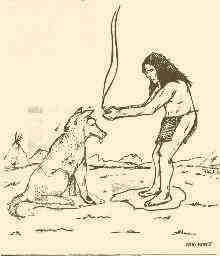
A legend of the Achomawi tells of a great flood that put out all the fires, leaving the people with no way to cook. From the top of Mt. Shasta, they saw a wisp of smoke rising in the west, so they set out toward it, carrying torches of cedar bark. Dog hid a plug of punk in his ear.
By evening, they reached the camp where fire was still burning. They asked if they could warm their hands and gathered around the fire. Dog lay down with his ear next to the blaze. Suddenly, the people thrust their torches into the fire, and then ran with their treasure. The fire owners were angry and knocked the torches out of the people's hands. They then caused a magic rain to fall and put out the torches.
So the people were forced to return home with no fire. When they arrived, Dog complained that he was hot. The people were angry and were about to throw him out when Dog told them to look in his ear. They found the smoldering punk and used it to rekindle their fires.
The Apache apparently had dogs with curving tails because they have a story to explain how this came about. Hoop-and -pole was a favorite gambling game of the Apache, in which a hoop was rolled along the ground and poles were thrown after it. Dog loved to play, but his hoop was his only possession, and he was always betting and losing it. So the people decided to give him a permanent hoop and curled his tail up over his back. This is why some dogs today carry their tails over his backs.
Dogs are also honored in a variety of dances. The Menominee performed their Dog Dance each spring in maple sugar camps. Each dancer had his own dish, just as each dog should have its own bowl, and went about miming a dog begging for syrup. The dancers were never refused because they would take the syrup anyway, just as a hungry dog will snatch food. The dance was performed to remind people of the powers possessed by dogs and of the dogs' traditional right to snatch food from men.
The Shaggy Dog Dance of the Gros Ventre of Montana is quite a different story. The legend goes that the people were traveling and left a shaggy dog behind (an unusual event, because dogs were valued possessions). The dog followed, and an old man of the tribe took pity on it. He waited for the dog to catch up, and he slept with it. In gratitude, the dog spoke to the man in a dream and gave him a dance, explaining how to perform it and giving the man the whistle, rattle and owl feather headdress worn during the dance. The old man performed the dance and received much honor.
In many Indian tribes, societies were formed based on dogs' admirable traits. The Braves Society of the Blackfoot began when a member of the tribe had a vivid dream in which he saw a band of fierce, loyal dogs. Like the dogs, the Braves watched over the camps and kept order. Whenever the camp was to move, the Braves spent the night curled up on the ground at the center of the camp. The next day, the tribe moved on and the society members stayed behind and ate any food that remained. Then, again like dogs, they followed slowly after the others, arriving after all the lodges had been pitched and fires were going.
The Crow had the Big Dogs Society. In a tribal hunt, if anyone moved prematurely and risked frightening the game, the Big dogs would advance menacingly and yell at him as if he were a dog. If the transgressor showed a willingness to obey, that was the end of it; otherwise, the Big Dogs might whip him severely. In battle, the Big Dogs were to take the initiative in an emergency. If enemies were entrenched, it was the Big dogs' duty to charge straight at them.
By far the largest society was that of the Dog Men of the Cheyenne. The four bravest men in each tribe were chosen to defend the tribe for one year. Each wore a sash of hide eight to ten feet long, called a dog rope. A wooden picket pin was attached to the bottom of the sash. Whenever a battle was going badly, the men wearing the dog ropes drove the pickets into the ground, attaching themselves in the midst of the battle, and fought desperately to cover the retreat of the rest of the tribe. They were expected to die rather than pull up the pins and retreat. But if a comrade ordered them away sharply, as if speaking to a dog, they could retreat with the others. Not surprisingly, the Dog Men regarded the dog as sacred.
Dogs were accorded a variety of powers. Navajo diviners would put earwax from a dog into their own ears to strengthen their powers of divining and listening. Dogs of the Kwakiutl were expected not only to hunt and guard but also to see that no sickness or invisible spirits entered the village. A Seneca chief is quoted as saying, "It is most true that whenever a person loves a dog, he derives great power from it. But if you do not love a dog, he has the power to injure you by his orenda" (the holy, mysterious, unknown and unknowable forces of the universe).
On the subject of dogs speaking, many tribes tell variations of the "Tattler" tale, in which Dog spies on members of the tribe and runs about telling tales. Consequently, it is denied the power of speech.
The Tlingit say that at the first Dog was like a human being, but he was too smart, and culture-hero Raven took him by the neck and pushed him down, saying "Have four legs and bark; you are nothing but a dog."
Other tribes believe that dogs still possess the power of speech. The Hupa and Yurok never converse with their dogs because the dogs might answer, which would be an omen of death or great calamity. The Papgo have an ever-greater fear, saying that if the dog were to answer, we would all turn to stone. Certainly something to think about the next time you're having a one-sided conversation with your own dog.
Article
From Dog Fancy 1990
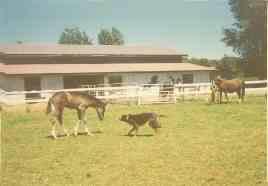
Song
Dog Kennels
3600 LAKESHORE DRIVE
SELMA, OREGON 97538
(541) 597-2871
EMAIL
